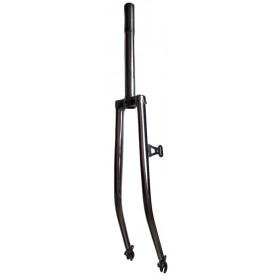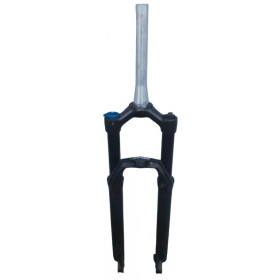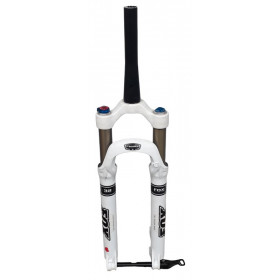 zoom_in
zoom_in
26 inch rigid chrome v-brake mountain bike fork
- 26
- 6 Items
- New
€48.99 VAT included
Rigid MTB fork: a lightweight, precise, and efficient alternative
When we talk about mountain biking, we often think of big suspensions, long travel, and components designed to absorb major impacts. Yet, a growing number of riders are turning to a simpler, more direct option: the rigid MTB fork. Minimalist and often lighter, it brings real advantages depending on the type of riding. Here’s a closer look at the features, benefits, and specifics of this essential component at the front of the bike.
What is a rigid MTB fork ?
Unlike traditional suspension forks that use springs, air, or oil to absorb shocks, a rigid fork has no suspension system. It’s a solid, non-moving part – usually made from steel, aluminum, or carbon – that directly connects the head tube to the front wheel hub via the steerer tube, fork crown, and fixed blades.
The lack of mechanical damping results in a more direct steering feel and a better connection to the terrain, which appeals to many purists – especially in bikepacking, urban MTB, or fast, rolling trails like fire roads or light off-road gravel.
Materials used for rigid MTB forks
The performance and feel of a rigid fork largely depend on the material it’s made of:
-
Chromoly steel: durable and naturally compliant, it absorbs vibrations well and is perfect for adventure or touring builds.
-
Aluminum: stiffer and lighter than steel, it offers a good weight-to-performance ratio but transmits more trail chatter.
-
Carbon fiber: ultra-light and high-performing, carbon is the material of choice for premium builds. It combines stiffness, responsive handling, and good vibration damping.
Technical specifications to know
Before switching to a rigid MTB fork, it’s essential to check a few technical points:
-
Steerer tube size: straight or tapered? It must match your frame’s head tube.
-
Axle-to-crown length: this measurement affects your bike’s geometry. A fork that’s too short or too long can alter the steering angle.
-
Axle type: thru-axle (15 mm or 12 mm) or quick release (QR)?
-
Brake compatibility: disc brakes (post mount or flat mount) or V-brakes?
-
Internal cable routing (in the case of hydraulic disc brakes).
-
Fork offset (rake): impacts handling in corners and high-speed stability.
Advantages of a rigid fork
-
Lightweight: up to 1 kg lighter than a suspension fork.
-
Low maintenance: no seals, no oil, no regular servicing required.
-
Precise handling: better responsiveness for technical riding.
-
Versatility: ideal for transforming a mountain bike into a commuter, cargo bike, or long-distance touring rig.
Best use cases for a rigid fork
A rigid fork is especially well-suited to certain disciplines:
-
Leisure or urban MTB: great for daily rides without rough terrain.
-
Gravel or fast XC: for riders seeking a responsive, efficient bike.
-
Bikepacking and touring: unmatched reliability and simplicity.
-
Technical singletrack without big drops: for skilled riders wanting a raw feel of the trail.
Conclusion
Choosing a rigid MTB fork means embracing simplicity, efficiency, and lightweight design. Perfectly suited to specific riding styles, it can completely change how your bike feels – offering direct, snappy handling and unmatched reliability on rolling terrain. Whether you're into minimalist builds, long-distance adventures, or simply want a dependable front end, the rigid fork is a serious option to consider.







